WP22 Exclusion Fouls
WP 22.1 It shall be an exclusion foul to commit any of the following offences (WP 22.4 to WP 22.18) which shall be punished (except as otherwise provided by the Rules) by the award of a free throw to the opposing team and the exclusion of the player who committed the foul.
WP 22.2 (see update below) The excluded player shall move to the re-entry area nearest to the player’s own goal line without leaving the water. An excluded player who leaves the water (other than following the entry of a substitute) shall be deemed guilty of an offence under WP 22.13 (Misconduct).
[NOTE: An excluded player (including any player excluded under the Rules for the remainder of the game) shall remain in the water and move (which may include swimming underwater) to the re-entry position nearest to the player’s own goal line without interfering with the play. The player may leave from the field of play at any point and then swim to reach the re-entry area provided the player does not interfere with the alignment of the goal.
On reaching the re-entry area, the excluded player shall be required to visibly rise to the surface of the water before the player (or a substitute) shall be permitted to re-enter in accordance with the Rules. However, it shall not be necessary for the excluded player to then remain in the re-entry area to await the arrival of an intended substitute.]
- UPDATED 2023 – WP5.6 and WP22.2 At any flying or rolling substitution, including in the re-entry area and swapping an excluded player, the two players must visibly high-five each other while in the re-entry area.
WP 22.3 The excluded player or a substitute shall be permitted to re-enter the field of play from the exclusion re-entry area nearest to the player’s own goal line after the earliest occurrence of one of the following:
(a) when 20 seconds of actual play have elapsed, at which time the secretary shall raise the appropriate flag provided that the excluded player has reached the re-entry area in accordance with the Rules;
(b) when a goal has been scored;
(c) when the excluded player’s team has retaken possession of the ball (which means receiving control of the ball) during actual play, at which time the defensive referee shall signal re-entry by a hand signal;
(d) when the excluded player’s team is awarded a free throw or goal throw, the referee’s signal to award the throw qualifies as the re-entry signal, provided that the excluded player has reached the re-entry area in accordance with the Rules.
The excluded player or a substitute shall be permitted to re-enter the field of play from the exclusion re-entry area nearest to the player’s own goal line, provided that:
(a) the player has received a signal from the secretary or a referee;
(b) the player shall not jump or push off from the side or wall of the pool or field of play;
(c) the player shall not affect the alignment of the goal;
(d) a substitute shall not be permitted to enter in the place of an excluded player until that player has reached the exclusion re-entry area nearest to the player’s own goal line except between periods, after a goal, or during a timeout;
(e) after a goal has been scored, an excluded player or a substitute may re-enter the field of play from any place.
These provisions shall also apply to the entry of a substitute when the excluded player has received three personal fouls or has otherwise been excluded from the remainder of the game in accordance with the Rules.
[NOTE: A substitute shall not be signalled in by a referee and nor shall the secretary signal the expiration of 20 seconds exclusion period until the excluded player has reached the re-entry area nearest to the player’s own goal line. This shall also apply to the re-entry of a substitute who is to replace a player excluded from the remainder of the game. In the event of an excluded player failing to return to the player’s re-entry area, a substitute shall not be permitted to enter until a goal has been scored or at the end of a period or during a timeout.
The primary responsibility for giving the signal for the re-entry of an excluded player or a substitute is with the defensive referee. However, the attacking referee may also assist in this regard and the signal of either referee shall be valid. If a referee suspects an improper re-entry or the goal judge signals such an improper re-entry, then the referee should first be satisfied that the other referee had not signalled the re-entry.
Before giving the signal for the re-entry of an excluded player or a substitute, the defensive referee should wait momentarily in case the attacking referee whistles to restore possession to the opponent’s team.
A change of possession does not occur merely because of the end of a period, but an excluded player or substitute shall be eligible to re-enter if the team wins the ball at the swim up at the start of the next period. If a player is excluded when the end of a period is signalled, the referees and the secretary shall ensure that the teams have the correct number of players before signalling for the restart.]
WP 22.4 For a player to leave the water or sit or stand on the steps or side of the pool during play, except in the case of accident, injury, illness or with the permission of a referee.
WP 22.5 To interfere with the taking of a free throw, goal throw or corner throw, including:
(a) intentionally to throw away or fail to release the ball to prevent the normal progress of the game;
(b) any attempt to play the ball before it has left the hand of the thrower.
[NOTE: A player is not to be penalised under this Rule if the player does not hear the whistle as a result of being under the water. The referees must determine if the actions of the player are intentional.
Interference with a throw may take place indirectly when the ball is hampered, delayed or prevented from reaching the player who is to take the throw, or it may occur when the execution of the throw is interfered with by an opponent blocking the direction of the throw (figure 6), by disturbing the actual movement of the thrower (figure 7) or by an opponent committing a foul under WP 20.2. For interference with a penalty throw, see also WP 22.17.]

WP 22.6 To attempt to block a pass or shot with two hands outside the 6 metre area.
WP 22.7 To splash in the face of an opponent intentionally.
[NOTE: Splashing is frequently used as an unfair tactic but is often only penalised in the obvious situation when players are facing one another (see figure 8). However, it can also occur less obviously when a player produces a curtain of water with an arm, seemingly without deliberate intent, in an attempt to block the view of the opponent who is about to shoot at goal or to make a pass.
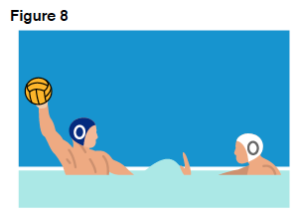
The punishment for intentionally splashing an opponent is exclusion under WP 22.7 or a penalty throw under WP 23.2 if the opponent is inside the 6 metre area and is attempting to shoot at goal. Whether to award a penalty throw or an exclusion is decided solely by the positioning and actions of the attacking player; whether the offending player is inside the 6 metre area or outside is not a decisive factor.]
WP 22.8 To impede or otherwise prevent the free movement of an opponent who is not holding the ball, including swimming on the opponent’s shoulders, back or legs. “Holding” is lifting, carrying or touching the ball but does not include dribbling the ball.
[NOTE: This Rule can also be applied to advantage the attacking team. If a counter attack is in progress and a foul is committed which limits the attack, the offending player shall be excluded.
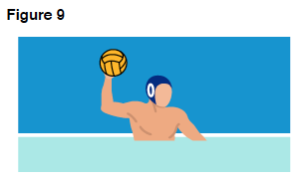
The first thing for the referee to consider is whether the opponent is holding the ball, because if the player is doing so, the player making the challenge cannot be penalised for “impeding”. It is clear that a player is holding the ball if it is held raised above the water (figure 9). The player is also holding the ball if the player swims with it held in the hand or makes contact with the ball while it is lying on the surface of the water (figure 10). Swimming with the ball (dribbling), as shown in figure 11, is not considered to be holding.
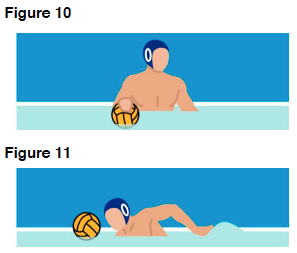
A common form of impeding is where the player swims across the opponent’s legs (figure 12), thus reducing the pace at which the opponent can move and interfering with the normal leg action. Another form is swimming on the opponent’s shoulders. It must also be remembered that the foul of impeding can be committed by the player who is in possession of the ball. For example, figure 13 shows a player keeping one hand on the ball and trying to force the opponent away to gain more space. Figure 14 shows a player in possession of the ball impeding the opponent by pushing the opponent back with the head. Care must be taken with figures 13 & 14, because any violent movement by the player in possession of the ball might constitute striking or even brutality; the figures are intended to illustrate impeding without any violent movement. A player may also commit the offence of impeding even if the player is not holding or touching the ball. Figure 15 shows a player intentionally blocking the opponent with the player’s body and with the arms flung open, thus making access to the ball impossible. This offence is most often committed near the boundaries of the field of play.]
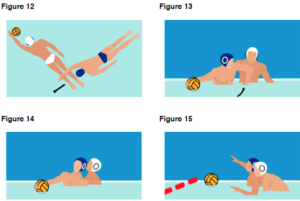
WP 22.9 To hold, sink or pull back an opponent who is not holding the ball. “Holding” is lifting, carrying or touching the ball, but does not include dribbling the ball.
[NOTE: The correct application of this Rule is very important both as to the presentation of the game and in arriving at a proper and fair result. The wording of the Rule is clear and explicit and can only be interpreted in one way: to hold (figure 16), sink (figure 17) or pull back (figure 18) an opponent who is not holding the ball is an exclusion foul. It is essential that referees apply this Rule correctly, without personal arbitrary interpretation, to ensure that the proper limits to rough play are not exceeded. In addition, referees must note that an infringement of WP 22.9 within the 6 metre area which prevents a probable goal must be punished by the award of a penalty throw.]
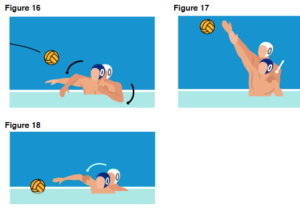
WP 22.10 To use two hands to hold an opponent not holding the ball anywhere in the field of play.
WP 22.11 (See 2023 update below) Upon a change of possession, for a defending player to commit a foul on any player of the team in possession of the ball, anywhere in the attacking team’s half of the field of play.
[NOTE: This Rule is to be applied if the team losing possession of the ball attempts to restrict the attack of the other team by committing a foul on any attacking player before that player has crossed the half-distance line.]
(2023 Updated rule) WP22.11 Tactical foul: Exclusion foul if a defending player commits a foul on an opponent with the intent to stop the flow of the attack, anywhere in the field of play.
WP 22.12 To kick or strike an opponent intentionally or make disproportionate movements with that intent.
[NOTE: The offence of kicking or striking can take a number of different forms, including being committed by a player in possession of the ball or by an opposing player; possession of the ball is not a decisive factor. What is important is the action of the offending player, including if the player makes disproportionate movements in an attempt to kick or strike, even if the player fails to make contact.
One of the most serious acts of striking is elbowing backwards (figure 19), which can result in serious injury to the opponent. Similarly, serious injury can occur when a player intentionally heads back into the face of an opponent who is marking the player closely. In these circumstances, the referee would also be justified in punishing the offence under WP 22.14 (Brutality) rather than under WP 22.12]
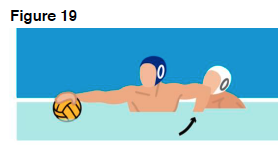
WP 22.13 To be guilty of misconduct, including the use of unacceptable language, aggressive or persistent foul play, to refuse obedience to or show disrespect for a referee or official, or behaviour against the spirit of the Rules and likely to bring the game into disrepute. The offending player shall be excluded from the remainder of the game, with substitution after the earliest occurrence referred to in WP 22.3, and must leave the competition area.
[NOTE: If a player commits any offence mentioned in this rule during the interval between periods, during a timeout, or after a goal, the player shall be excluded for the remainder of the game and a substitute shall be eligible to re-enter immediately prior to the restart of the game as all these situations are considered to be interval time. Play will restart in the normal manner.]
WP 22.14 To commit a violent action (before 2023 listed as an act of brutality rather than violent action) (including to play in a violent manner, kicking, striking or attempting to kick or strike with malicious intent) against an opponent or official, whether during actual play, during any stoppages, timeouts, after a goal has been scored or during intervals between periods of play.
Should this occur during the game the offending player shall be excluded from the remainder of the game and must leave the competition area and a penalty throw awarded to the opposing team. The offending player may be substituted when four minutes of actual play have elapsed.
Should the incident occur during any stoppage, timeout, after a goal or interval between periods of play, the player shall be excluded for the remainder of a game and must leave the competition area. No penalty throw shall be awarded. The offending player may be substituted when four minutes of actual play have elapsed and play will restart in the normal manner.
If the referees call simultaneous brutalities or actions of play in a violent manner on players of opposing teams during play, both players are excluded for the remainder of the game with substitution after four minutes of actual play have elapsed. The team, which had possession of the ball, will first shoot a penalty throw followed by the other team shooting a penalty throw. After the second penalty throw, the team, which had possession of the ball, will restart play with a free throw on or behind the half distance line.
WP 22.15 In the case of simultaneous exclusion of players of opposing teams during play, both players are excluded for 20 seconds. The possession clock is not reset. Play is restarted with a free throw to the team which had possession of the ball. If neither team had possession when the simultaneous exclusions were called, the possession clock is reset to 30 seconds and play shall be restarted with a neutral throw.
[NOTE: Both players excluded under this Rule, shall be permitted to re-enter at the next earliest occurrence referred to in WP 22.3 or at the next change of possession.
If two players have been excluded under this Rule and are eligible to re-enter, the defensive referee may wave in the player as soon as that player is ready to re-enter. The referee does not have to wait until both players are ready to re-enter.]
WP 22.16 For an excluded player to re-enter or a substitute to enter the field of play improperly, including:
(a) without having received a signal from the secretary or referee;
(b) from any place other than the player’s exclusion re-entry area, except where the Rules provide for immediate substitution;
(c) by jumping or pushing off from the side or wall of the pool or field of play;
(d) by affecting the alignment of the goal.
(e) for a flying substitute to enter the field of play not following the correct flying substitution prodecure as mentioned in WP 5.6 and WP 5.6.1
If this offence is committed by a player of the team not in possession of the ball, the offending player shall be excluded and a penalty throw awarded to the opposing team. This player receives only one personal foul, which should be marked by the secretary as exclusion penalty.
If this offence is committed by a player of the team in possession of the ball, the offending player shall be excluded and a free throw awarded to the opposing team.
WP 22.17 To interfere with the taking of a penalty throw. The offending player shall be excluded from the remainder of the game with substitution after the earliest occurrence referred to in WP 22.3 and the penalty throw shall be maintained or re-taken as appropriate.
[NOTE: The most common form of interference with a penalty throw is when an opponent aims a kick at the player taking the throw, just as the throw is about to be taken. It is essential for the referees to ensure that all players are at least 2 metres from the thrower, to prevent such interference taking place. The referee should also allow the defending team the first right to take position.]
WP 22.18 For the defending goalkeeper to fail to take up the correct position on the goal line at the taking of a penalty throw having been ordered once to do so by the referee. Another defending player may take the position of the goalkeeper but without the goalkeeper’s privileges or limitations.
WP 22.19 When a player is excluded, the exclusion period shall commence immediately when the ball has left the hand of the player taking the free throw or when the ball has been touched following a neutral throw.
WP 22.20 If an excluded player intentionally interferes with play, including affecting the alignment of the goal, a penalty throw shall be awarded to the opposing team and a further personal foul awarded against the excluded player. If the excluded player does not commence leaving the field of play almost immediately, the referee may deem this to be intentional interference under this Rule.

















